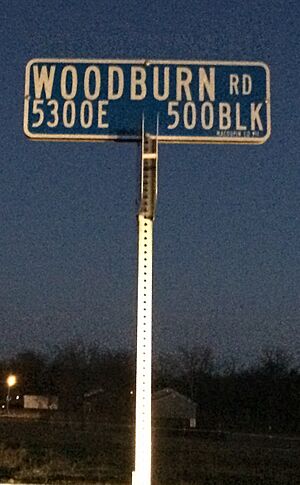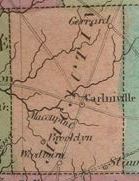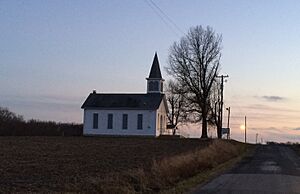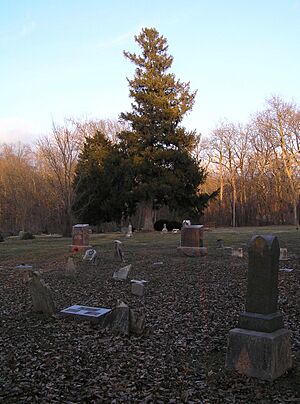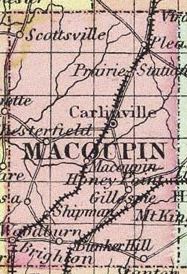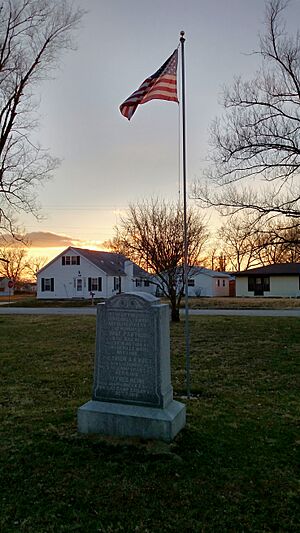Woodburn, Illinois facts for kids
Quick facts for kids
Woodburn, Illinois
|
|
|---|---|
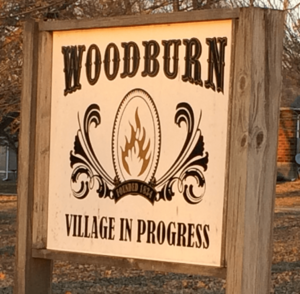 |
|
| Country | United States |
| State | Illinois |
| County | Macoupin |
| Established | 1834 |
| Elevation | 640 ft (195 m) |
| Population
(1911)
|
|
| • Total | 175 |
| Time zone | UTC-6 (Central (CST)) |
| • Summer (DST) | UTC-5 (CDT) |
| ZIP code |
62014
|
| Area code(s) | 618 |
| GNIS feature ID | 421419 |
Woodburn is a small place in Macoupin County, Illinois, United States. It's called an unincorporated community, which means it's not officially a town or city with its own local government. Instead, it's part of a larger area called Bunker Hill Township.
Contents
Where is Woodburn Located?
Woodburn is found where two roads meet: the Brighton-Bunker Hill Road and the old Alton-Springfield stagecoach road. Today, this old road is known as Woodburn Road to the south and Shaw Road to the north.
Other nearby places include Bunker Hill (about 3.4 miles east) and Brighton (about 7 miles west).
Woodburn's Past: A Rich History
Even though Woodburn is quiet now, it has a very interesting past. For its first 50 years, it was one of the most important places in the area.
How Woodburn Started
The last Native American camp in the Woodburn area was left in 1826. Some Native Americans were still seen hunting until 1830. But, more European settlers arrived, and a big snowstorm killed many deer, which led the Native Americans to move west.
An old Indian trail passed through the Woodburn area, connecting what is now Alton to Carlinville. This trail helped guide new settlers to the region.
Around 1816, the Wood brothers from Kentucky camped here while looking for land. People say the name "Wood Burn" came from watching their campfire. This name later became "Woodburn."
In 1833, a state road from Alton to Springfield was planned to follow this old Indian trail. The town of Woodburn was officially laid out in 1834 by Dr. B.F. Edwards. He planned for nine blocks, including one for a public park.
Growing into an Important Place
Woodburn grew quickly in its early years. As it became more important, new businesses, schools, and churches were built.
Becoming Well-Known
Woodburn became the main center for its township (a small local area). In 1836, some land was set aside for a town square. This was in case Woodburn became the county seat (the main town for the whole county), which would need space for a government building. Woodburn never became the county seat, but it was an important stop on the stagecoach route from Alton to Springfield. Here, tired horses were swapped for fresh ones.
A post office opened in Woodburn in 1837. In 1839, the Whig political group celebrated Independence Day in Woodburn. A very famous speaker, Abraham Lincoln, was there!
Early Businesses
The first building in Woodburn was a store, built by E.J. Miner in 1835. The first house was built that same year by Elijay Dodson. Dr. Edwards also built a large inn for travelers.
In 1836, the first steam sawmill in the county was built in Woodburn. Later, in 1841, it was turned into a flour mill. This made Woodburn more modern than other places nearby. The town also had a brick kiln, a blacksmith shop, and even a tree nursery. Over time, Woodburn had many different professionals, including doctors, a dentist, carpenters, and butchers.
Local Industries
Farming was, and still is, the main industry in the Woodburn area. Many families, including the Wood family, had farms here.
Richard Welch had several fruit orchards and started a business drying apples. This created jobs for people who operated the dryers and prepared the apples.
Castor oil was also made in Woodburn from castor beans. This oil was used as a lubricant until petroleum was found in 1854. Petroleum was much cheaper.
There were also two coal mines near Woodburn around 1935. One mine had to close because it kept flooding with water. Another mine, the Hausman Mine, was more successful and was later sold to a company from out of town.
Schools in Woodburn
The first school in Woodburn was held in the Baptist Church. A brick school building was finished in 1846. This school quickly became too small, so some students were taught in the Congregational church. Later, a bigger two-story brick school was built, which lasted until 1913. Students could even take advanced classes like botany and music.
Another school, called Liberty School (but known as Benner School), was built on land donated by the Benner family. In 1907, this school had 36 students and 64 books in its library.
Churches in the Community
The first church group in Woodburn was Baptist, formed in 1835. They built their church in 1843.
The first church building in town was the Congregational Church, built in 1838. It started with 40 members. A new brick church was built in 1854 and used until 1960.
The Woodburn Presbyterian Church was started in 1880. It was built on a hill about 2 miles from town, and its bell tower can be seen from far away.
Other churches existed but are no longer around, including a Methodist church and a Christian church.
Woodburn citizens were also very generous. After the Great Chicago Fire of 1871, the Congregational Church donated money to help. One member, Rosa Bird, was a missionary who died in China during the Boxer Rebellion in 1900.
Cemeteries in Woodburn
The Wood Cemetery, located about two miles south of town, has graves dating back to at least 1823. Many of Woodburn's first families are buried here, including members of the Wood family who helped found the town.
The Woodburn Cemetery was started in 1866 on the edge of town. It includes an older burial ground used by the Rider family. The oldest grave here is from 1844. Many soldiers are buried in this cemetery.
Why Woodburn Shrank
The railroad was originally planned to go through Woodburn. However, the decision was changed, and the railroad went through Bunker Hill instead. Since train travel was much faster than stagecoach, Bunker Hill began to grow, and Woodburn started to become smaller.
Woodburn officially became an incorporated village in 1867, but this was when its growth peaked. By 1891, its population was only 267 people, and by 1911, it had dropped to 175.
The Woodburn post office closed in 1907.
In 1948, many small rural schools, like Benner School, began to close. Children were then taken by bus to larger, central schools. By 1952, the Woodburn school was one of only two schools left in its district.
Also in 1948, a tornado that badly damaged Bunker Hill also destroyed several homes in Woodburn and caused four deaths.
The last general store in Woodburn closed in 1975.
Woodburn Today
Today, Woodburn looks like a simple group of homes, but some features still hint at its past.
A monument stands in the public square to honor three local soldiers who died during World War I: George Partridge, Dietrich A.H. Rust, and Alfred Heine.
Many of the old gravestones in both Wood Cemetery and Woodburn Cemetery are hard to read now, but some have been replaced with newer ones.
The current Baptist Church (Calvary) has met in the old Woodburn School building since 1956. They have made many improvements over the years, including adding a brick front, a parsonage, a baptistry, and a bell tower.
The Congregational Church was rebuilt after a storm in 1960 and is now called Woodburn Bible Church.
The former Presbyterian Church is now known as Country Bible Church.
You can buy home-canned foods at the Woodburn Country Store, which is the only visible business in the village today.
A water tower with the village name stands on the northern edge of Woodburn.




